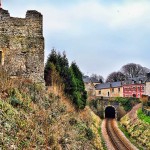Fecamp is a small coastal city with an active fishing fleet. The fishing fleet is central to the city, since the fishing boats have been going to Newfoundland for over a century to fish for cod, and another large portion of the fleet fished for herring.
The city used to have several herring smoking factories, but all have disappeared today. The last herring factory is being turned into a museum, however, next to the new museum is a bar/restaurant that has maintained and restored one of the smoking walls.
The city itself is squeezed in between two cliffs while the Valmont river runs through the city. The city has a long beach (like most of Upper Normandy, the beach is made out of pebbles, not sand), two pleasure boat marinas, fishing boats and their resulting fish markets and an active wood industry imported from Scandinavia.
The earliest recording in history of Fecamp dates back to 875 AD. Fecamp was during several years the main quarters of the Duke of Normandy. Their castle can still be seen, but it is in ruins.

Lighthouses of Fecamp
At the maritime entrance of Fecamp are two lighthouses attached to land by a wooden pier (open to public).

There are two lighthouses at the harbour entrance. The tallest (pictured above) was built in 1836 but destroyed during WWII by the Germans. It is 14.5 meters high.

The two long piers go all the way to the entrance of the marina. On one side you can see a row of fishermen houses.

A close inspection of the fishermen houses will show you that they are very small and narrow. Each house usually consists of a single room and stairs to the upper levels. Like on ships, the ceilings are low.
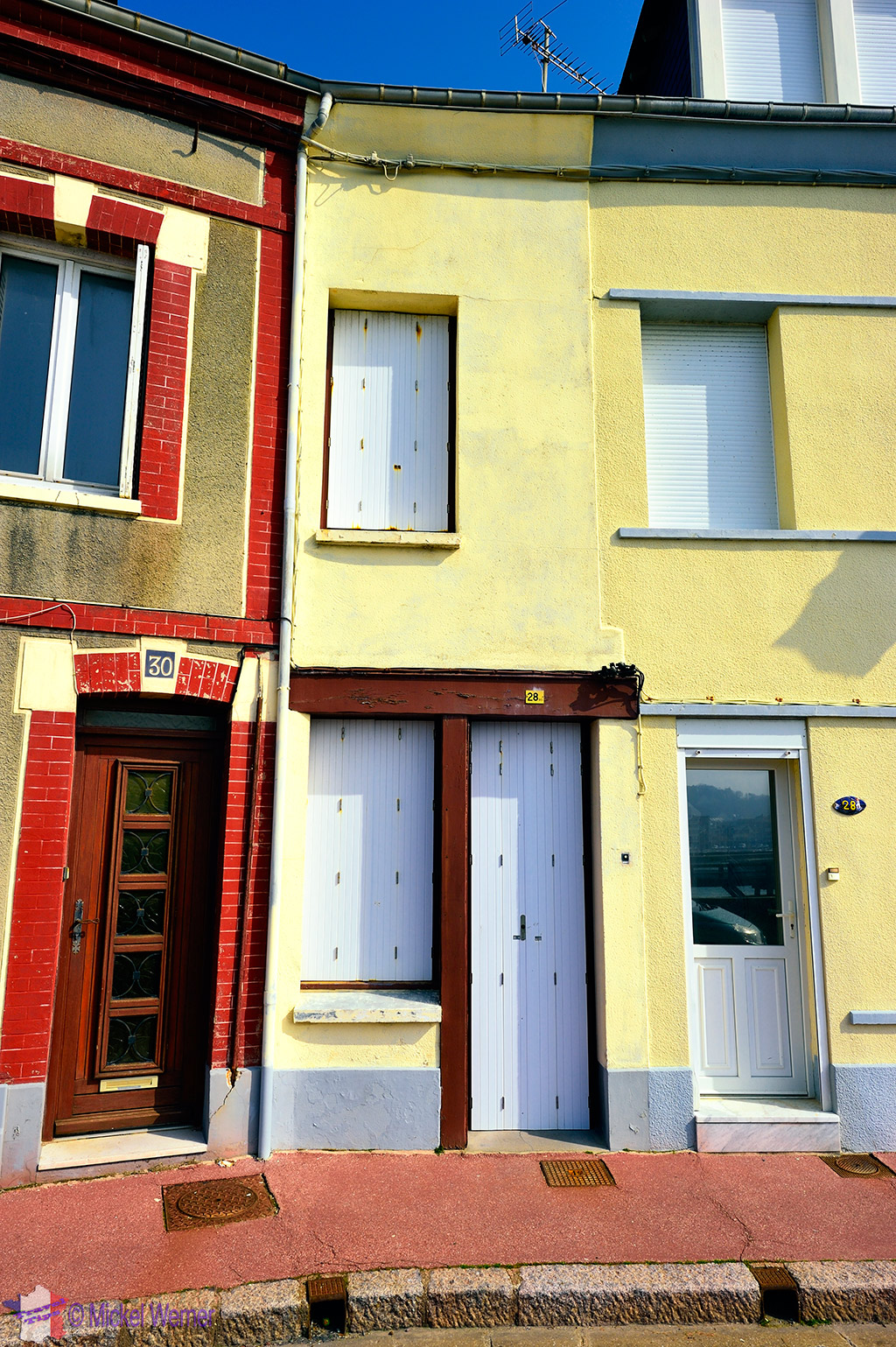
TIP: Today, Fecamp’s biggest claim to fame comes from their Benedictine factory and museum, a “must-see” if you are in the area. More about this incredible beautiful Palace that houses the factory and museum can be found by clicking here.
World War II
During World War II, Fecamp was a main defence position for the Germans. A very long and deep fortified bunker complex was built on the main cliff of Fecamp (that part of the cliff is called Cap Fagnet). At the harbour side you can still some enormous fortifications:

The underground network of the bunkers goes on for kilometres. There are several levels with at the highest levels stairs to many of the observation and defence posts.

It is only in recent years that the authorities discovered a complete hospital, including operating rooms, hidden away inside the cliffs, capable of handling up to 80 patients.
TIP: During the summertime the bunker can be visited but only with a guide. If you are interested, you will need to contact the tourist office for a reservation. The phone number is: +33 (0) 2 35 28 51 01. Click here to access their web site.
The Cliffs
On top of these cliffs (height is 110 meters) is a converted farm and chapel. The farm is now a hotel, which includes a small swimming pool. The chapel, Notre-Dame de Salut, is open to the public and can be visited and was primarily used for the sailors who went to sea.

The area around the farm/hotel is ideal to park to visit the cliffs and WWII bunkers. A large public car park has been built close-by. On one side you can see Fecamp (as shown on the top photo), and on the other side you can see the cliffs stretching for miles.
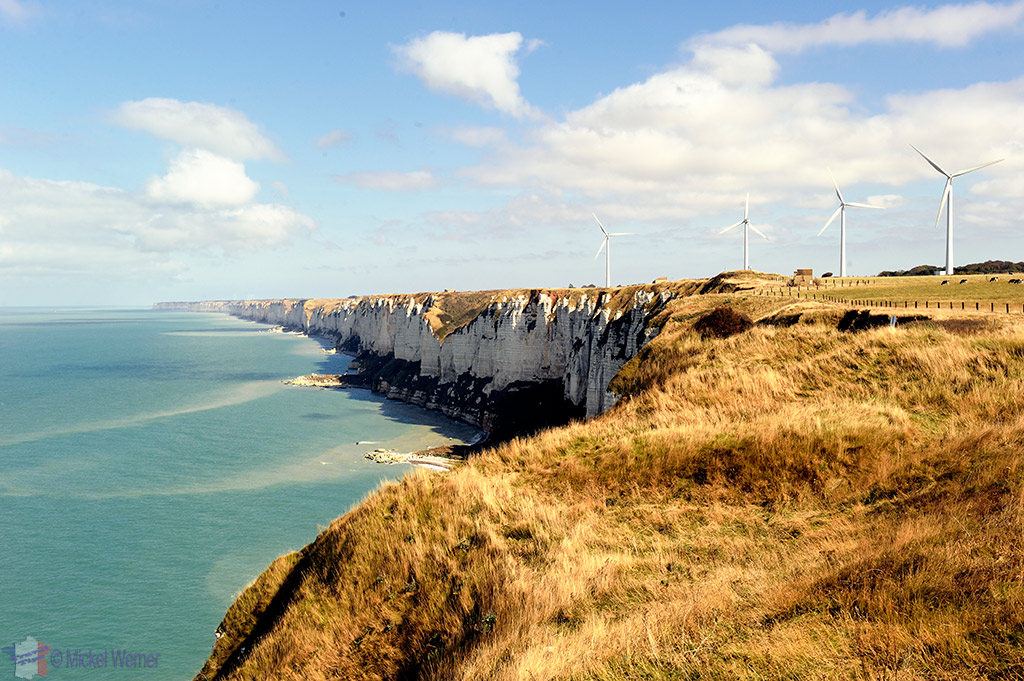
You can also see the WWII bunkers on the top.
WARNING: The cliffs are eroding and can topple over at any moment. Although there are many hiker paths, you are expected to stay several metres away from the edge.
Fecamp Harbour
The harbour at Fecamp is divided into two pleasure boat marinas, one which is dependent on a lock/bridge which only opens at certain times of the day. The other can be accessed at any moment. The fishing fleet has its own area and at the furthest edge of the harbour you can find occasional cargo ships loading and offloading wood.
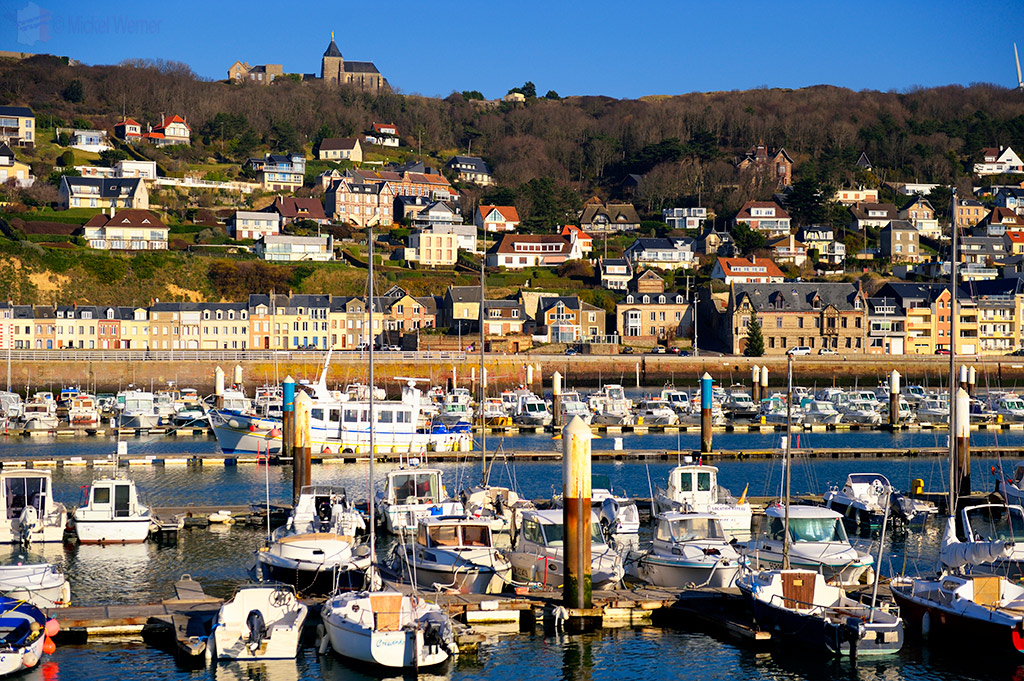
The main road giving access to Fecamp crosses part of the harbour. The road arrives via a drawbridge that opens on preset hours of the day, and when open, results in daily traffic jams.
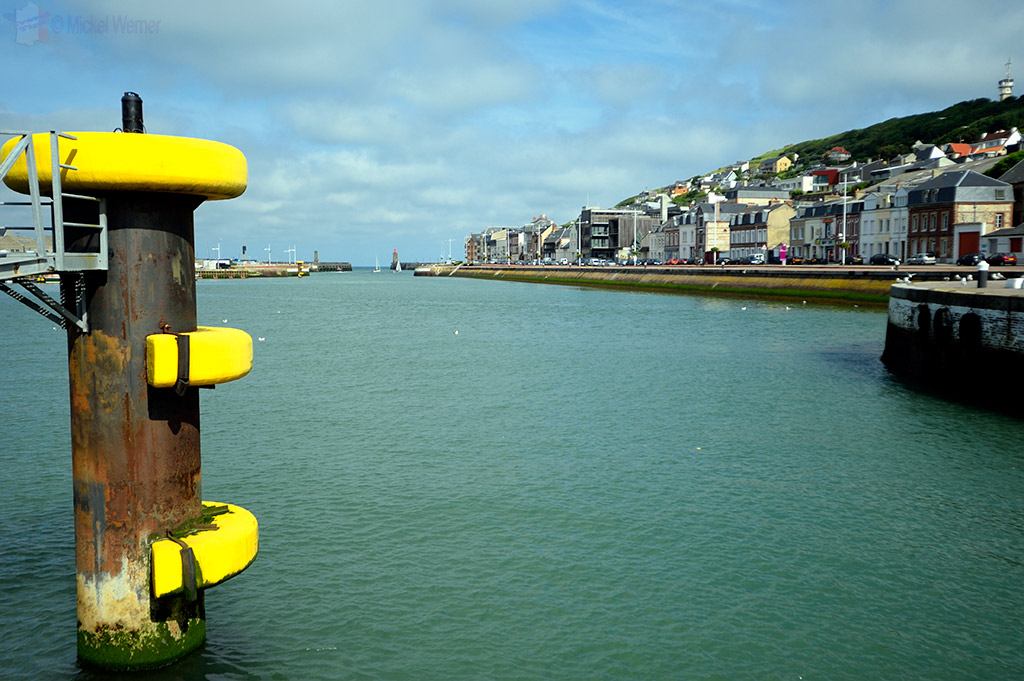
The Fishing industry was the mainstay of Fecamp, and therefore you will find a rather big and well presented museum in the centre of the harbour in one of the old fish factories. It’s worth a visit, if not just for the killer view from the top observatory floor.

Click here to read more about the Fisheries Museum.
City Hall/Abbey
The city hall is built onto the Trinity Abbey (Abbaye de la Trinité) church. The abbey itself was built starting in the year 659 and belongs to the Benedictine order.

Click here to read our review of the enormously long abbey.
Saint-Etienne de Fecamp church
Another rather large church and square dominate Fecamp. The church, Saint-Etienne de Fecamp is located before a large square.
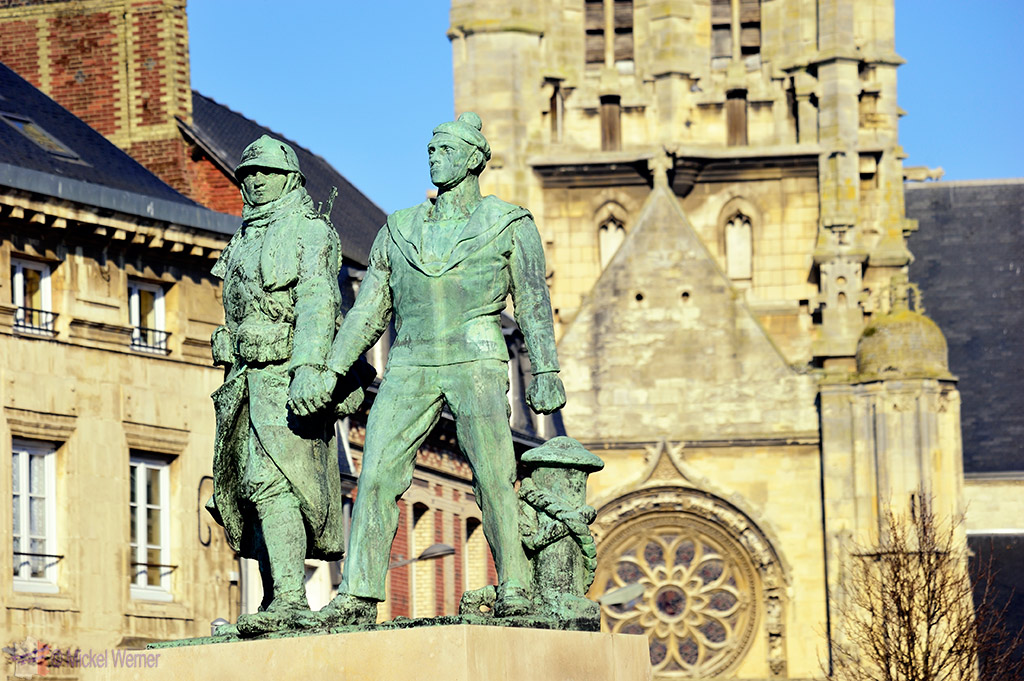
On the square, and around it, on every Saturday you will find a big and very busy market. But it is inside that the real action takes place; a real farmers market with farmers coming from around the area selling their food directly to the consumers. Usually it is food that was picked that morning, often still carrying the dirt and mud.

Often the farmers come with cool-boxes and sit on the ground selling their wares.
GR21
Fecamp is part of the long distance hiking path, GR21, which brings you from Le Havre to Le Treport via the cliffs over some 180 kms.
Fecamp and the Artists
Fecamp is a picturesque fishing town which made for a great backdrop for many artist. Here are all the artists who applied their arts in the town and its surroundings (a link “⇠” will appear when we have published an article on this artist’s works in Fecamp):
NOTE: a “*” besides the artist’s name indicates that the artist did NOT work directly in Fecamp, instead worked in Fecamp’s surroundings only.
- 🇺🇸 Boggs, Frank Myers ⇠
- 🇷🇺 Bogolyubov, Alexey (Alexei) ⇠
- 🇫🇷 Boudan, Louis * ⇠
- 🇫🇷 Boudin, Eugene-Louis ⇠
- 🇫🇷 Bourgeois, Constant ⇠
- 🇫🇷 Burel, Henry E. ⇠
- 🇺🇸 Butler, Theodore Earl ⇠
- 🇬🇧 Callow, William ⇠
- 🇬🇧 Conder, Charles * ⇠
- 🇬🇧 Cooke, Edward William ⇠
- 🇬🇧 Cotman, John Sell ⇠
- 🇫🇷 Cyr, Georges Albert ⇠
- 🇫🇷 de Jolimont, Theodore Basset * ⇠
- 🇫🇷 Dufy, Raoul ⇠
- 🇫🇷 Garneray, Ambroise Louis ⇠
- 🇫🇷 Gernez, Paul-Elie ⇠
- 🇳🇱 Kickert, Conrad Theodore ⇠
- 🇫🇷 Kuwasseg, Charles Euphrasie ⇠
- 🇫🇷 Letellier, Emile-Andre ⇠
- 🇫🇷 Loiseau, Gustave ⇠
- 🇫🇷 Maclet, Elisee ⇠
- 🇫🇷 Marquet, Albert ⇠
- 🇫🇷 Maufra, Maxime * ⇠
- 🇬🇧 Meadows, Arthur Joseph ⇠
- 🇫🇷 Michallon, Achille-Etna ⇠
- 🇫🇷 Monet, Claude ⇠
- 🇫🇷 Morisot, Berthe ⇠
- 🇫🇷 Noel, Jules Achille
- 🇫🇷 Pecrus, Charles Francois ⇠
- 🇫🇷 Pissarro, Camille * ⇠
- 🇫🇷 Renoir, Pierre-Auguste * ⇠
- 🇫🇷 Roullet, Gaston ⇠
- 🇬🇧 Schafer, Henry Thomas ⇠
- 🇫🇷 Schuffenecker, Claude-Emile * ⇠
- 🇫🇷 Signac, Paul
- 🇬🇧 Smallwood, William Frome ⇠
- 🇬🇧 Stanfield, Clarkson Frederick ⇠
- 🇧🇪 Timmermans, Louis-Etienne ⇠
- 🇩🇪 Weber, Theodore Alexander ⇠
Conclusion
Fecamp is a very pretty small city with an enormous potential. It’s very underutilized due to bad investments. Roads are very bad, buildings are not maintained and infrastructure is sadly missing. However, it has a certain charm that makes Fecamp a nice weekend getaway place.
Related Posts
- 10000
- 10000
- 10000
- 10000
- 10000


